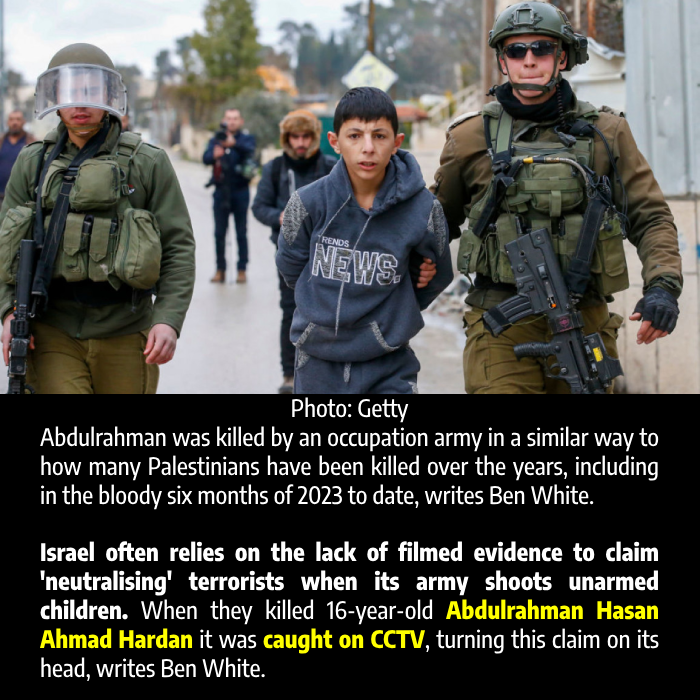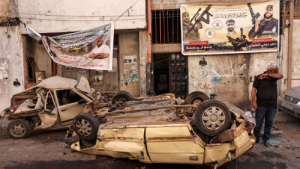By Ben White.

The Israeli military’s invasion of Jenin and its refugee camp on 3-5 July was intensely violent. 12 Palestinians were killed, while more than 140 were injured. Deploying huge numbers of ground forces as well as armoured drones, the military assault damaged 460 housing units, including 23 destroyed homes and another 47 that were left uninhabitable. There was significant damage to vital civilian infrastructure, and the camp’s UNRWA health clinic sustained “extensive damage.”
As the assault unfolded, the Israeli military’s public relations materials distributed to the media stressed that the invasion was focused on, and justified by the need for, targeting “terrorists” based in Jenin refugee camp. As casualties mounted, and the scale of the destruction became clear, the Israeli military honed in on one key message: no non-combatants were killed.
On 4 July, however, even as the offensive was ongoing, Defence for Children International – Palestine (DCI-P) released a statement that an Israeli sniper had killed 16-year-old Abdulrahman Hasan Ahmad Hardan. He was shot in the head with live ammunition in the middle of the day, as he stood in front of Al-Amal Hospital. DCI-P stated clearly that Abdulrahman “was unarmed and there were no confrontations between Israeli forces and armed Palestinians in the area when he was shot.”
”This egregious killing of an unarmed child in broad daylight, and the Israeli occupation authorities’ attempts to deceive and retroactively justify the killing, is a significant case study – not least, unfortunately, because it is unlikely to be the last such killing and (attempted) cover-up.”
The next day, the Israeli army withdrew, continuing to tell the world’s media that not a single non-combatant had been killed during the invasion.
It was a few days later, on 9 July, that Catherine Philp, an experienced foreign correspondent with The Times, published a remarkable report. Not only did CCTV footage confirm that Abdulrahman had been killed while unarmed, but the Israeli military had deliberately tried to mislead journalists. Two days later, the BBC’s Tom Bateman followed up with a report confirming Philp’s piece, and also referencing a second video, showing the moments immediately after he had been shot – again, with no weapons visible in the area where Hardan was shot.
This egregious killing of an unarmed child in broad daylight, and the Israeli occupation authorities’ attempts to deceive and retroactively justify the killing, is a significant case study – not least, unfortunately, because it is unlikely to be the last such killing and (attempted) cover-up.
According to The Times, Israeli military spokesperson Lieutenant-Colonel Richard Hecht made three claims when asked about the killing of Abdulrahman – all before he had seen the CCTV. First, that Abdulrahman “was not a child;” oddly, Hecht made this claim despite believing Abdulrahman to be 17-years-old. He was 16 – but either way, he was legally a child. Second, Hecht pointed to social media posts by Islamic Jihad “claiming him [Abdulrahman] as a fighter.” Finally, when asked directly if Abdulrahman “had been armed,” the military spokesperson replied “yes,” with “an automatic rifle.”
The BBC report, meanwhile, noted comments given by Hecht last week regarding casualties. “There were 12 people killed, every one that was killed was involved directly with terrorism”, he had told them. “A 17-year-old may be regarded as a minor but he’s holding weapons and firing…We can show that evidence. We have pictures of all of them, and intel that they were involved.”

After a recent offensive on Jenin refugee camp, Israel continues to justify its actions through propaganda & criminalising Palestinians. But Palestinians exercising self-defence is not terrorism, they have a right to resist, argues Emad Moussa.
Then, in a new statement provided to the BBC, the Israeli military added an additional, ludicrous claim – that it was not even certain the video did indeed show the shooting of Abdulrahman. Disturbingly, the spokesperson then indirectly attacked The Times’ report, which it accused of having “discounted the Islamic Jihad’s claim of responsibility for the neutralised terrorist and his association with the terrorist organisation.” Thus, doubling down, and in possession of the CCTV footage, the Israeli army described a child shot in the head by one its snipers as a “neutralised terrorist.”
Abdulrahman was killed by an occupation army in a similar way to how many Palestinians have been killed over the years, including in the bloody six months of 2023 to date. Most of the time, the Israeli military issues a perfunctory statement along the lines of troops having come under fire, and having returned fire – sometimes adding, “hits were detected.”
That is all that the army spokesperson typically publishes, and is rarely asked to explain or elaborate on the specific circumstances in which a Palestinian has been killed.
Some of those killed have, of course, been members of armed groups – and the majority of those have been shot dead while putting up resistance to Israeli forces raiding Palestinian cities and refugee camps. But many Palestinians killed by the army were not armed at the time they were shot.
In these instances, the military, Israeli journalists, or pro-Israel social media accounts, often publish photos supposedly depicting the slain individual posing with a gun or factional insignia at some unknown date and in an unspecified context. Similarly, when Palestinian factions claim someone, this is taken at face value (or at least is presented as such) as conclusive ‘proof’ of someone’s supposed involvement in armed activity (including, the implication is, at the time they were killed).

A stronghold of the Palestinian struggle, Jenin refugee camp is no stranger to Israeli violence. Despite the death and destruction caused by the recent invasion, the community’s spirit remains steadfast, writes Yara Hawari.
READ: In Palestine, Jenin refugee camp is a symbol of resistance and community
But this is all smoke and mirrors. As Omar Shakir, the Israel-Palestine director of Human Rights Watch, told The Times, “a claim of factional affiliation by a Palestinian group does not suffice to legally justify a killing by Israeli forces, under international human rights law applicable in the West Bank.” He added: “The determination of legality here turns on whether the person posed an imminent threat to life when fatally shot. Palestinian factions claim individuals were affiliated, irrespective of whether they were a part of an armed group or involved in fighting when killed.”
It is that determination of legality which the Israeli military and social media disinformation actors are set on obscuring. In the case of the killing of Abdulrahman, the Israeli military spokesperson initially told journalists that the teenager had a weapon when shot. He did not – but in most cases, there is no CCTV with which to debunk the spokesperson’s claim. With the evidence clear that Abdulrahman was unarmed, the army has focused entirely on an alleged factional affiliation rejected by his family and for which the army has no independent proof of its own – and, which, even if true, would not alter the illegality of shooting an unarmed child in the head.
This is a case to remember every time that the Israeli military claims to have fired back at gunmen, or tells journalists that the young man their soldiers shot during a raid was a “terrorist.” Exposing such crimes and the attempted cover-up will not impact on the systematic impunity within the Israeli army – but such documentation is a vital part of contesting the dehumanisation of Palestinians under military occupation, and, of efforts to secure international accountability.
Ben White is a writer, analyst, and author of four books, including ‘Cracks in the Wall: Beyond Apartheid in Palestine/Israel’.
Follow him on Twitter: @benabyad
Source: The New Arab. 18 July 2023
RELATED:
CCTV Caught Israel Lying Shooting Dead Unarmed Child!#FreePalestine #Jenin #WarCrimes #Murder #Minor #AbdulrahmanHardan https://t.co/J5qw2PhLjr
— PGPF (@perdana4peace) July 11, 2023